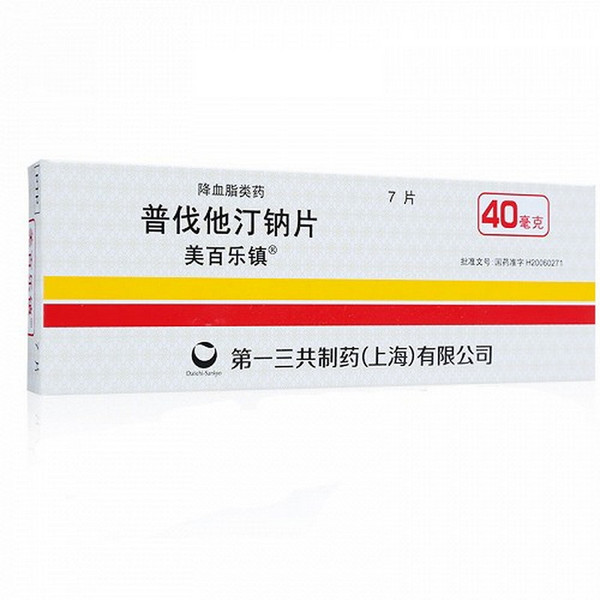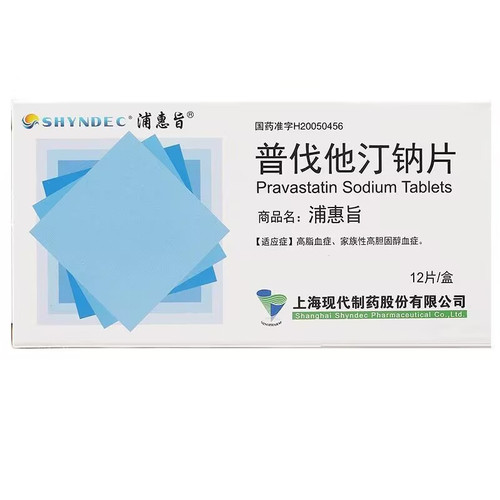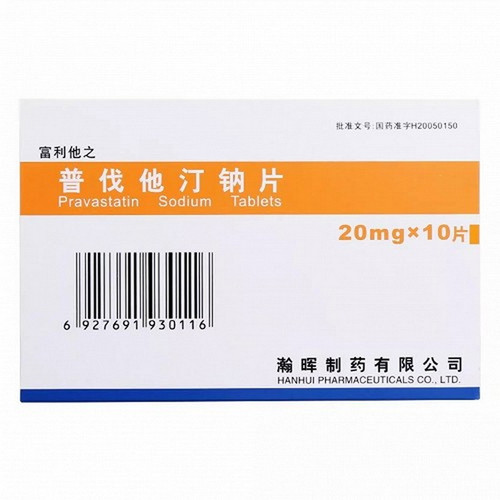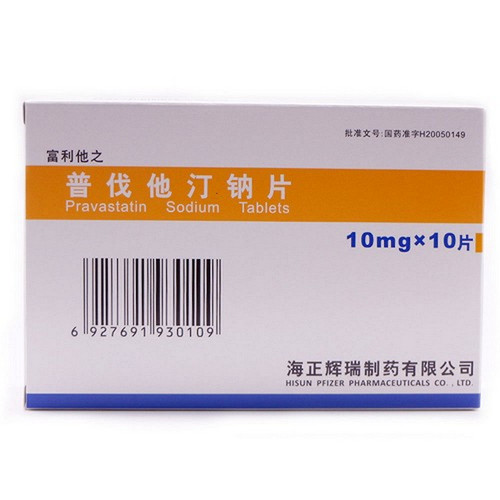Product Overview
[Drug Name]
Generic Name: Pravastatin Sodium Tablets
Trade Name: Meibai Lezhen
English Name: Pravastatin Sodium Tablets
Chinese Pinyin: Pufatatingna Pian
[Ingredients]
Pravastatin Sodium (Pregnancy Grade: X) Molecular Formula: C23H35NaO7 Molecular Weight: 446.52
[Properties]
This drug is a white to slightly grayish yellow powder or crystalline powder. It is odorless and bitter in taste. It is freely soluble in water, methanol, or glacial acetic acid, slightly soluble in anhydrous ethanol, and virtually insoluble in anhydrous acetic acid or ether.
[Indications]
Hyperlipidemia, familial hypercholesterolemia.
[Dosage and Administration]
The starting dose for adults is 10-20 mg once daily, taken at bedtime. The dose should be increased or decreased based on age and symptoms. The maximum daily dose is 40 mg.
[Adverse Reactions]
Of the 11,224 patients, 329 (2.93%; this item includes side effects for which the incidence cannot be calculated) experienced side effects (including abnormal clinical laboratory values), primarily rash (0.11%), diarrhea (0.08%), and gastric discomfort (0.07%). 1. Major Adverse Reactions (Incidence Unknown): 1) Rhabdomyolysis: Rhabdomyolysis is characterized by muscle pain, fatigue, elevated CPK, and elevated blood and urine myoglobin. This can lead to severe renal damage, including acute renal failure. If these symptoms occur, the drug should be discontinued immediately. 2) Hepatic Insufficiency: Liver dysfunction, accompanied by jaundice and significant elevations in AST and ALT, may occur. Therefore, careful observation is recommended. In such cases, the drug should be discontinued immediately and appropriate treatment should be administered.
[Contraindications]
This product is contraindicated in patients with a history of hypersensitivity to it or any of its ingredients.
[Precautions]
Like other HMG-CoA reductase inhibitors, this drug may increase alkaline phosphatase and transaminase levels. Liver function tests are recommended before dose adjustments or as needed. This drug is contraindicated in patients with active liver disease or persistent, unexplained transaminase elevations. Caution is advised in patients with recent liver disease, those with symptoms suggestive of liver disease (e.g., persistent, unexplained transaminase elevations, jaundice), or those with alcoholism. For these patients, it is advisable to start at the lowest recommended dose and titrate gradually to an effective therapeutic dose while closely monitoring them. During treatment, if patients develop elevated transaminases or symptoms or signs of liver disease, liver function tests should be repeated until liver function returns to normal. Discontinue this drug if AST or ALT levels persistently exceed 3 times or more of the upper limit of normal. This drug has rarely caused rhabdomyolysis with acute renal failure secondary to myoglobinuria, which can cause uncomplicated myalgias. Myopathy manifests as muscle tenderness or weakness near joints, with elevated creatine phosphokinase (CPK) levels exceeding 10 times the upper limit of normal. Patients with diffuse myalgia, tenderness, or weakness, and/or significantly elevated CPK levels should consider the possibility of a myopathy. Muscle pain, tenderness, or weakness, especially if accompanied by fatigue or fever, requires prompt and detailed evaluation and appropriate treatment. If a significantly elevated CPK level indicates suspected or confirmed myopathy, discontinue this drug. Discontinue this drug if the patient develops acute or severe conditions that could lead to acute renal failure secondary to rhabdomyolysis, such as sepsis, hypotension, major surgery, trauma; severe metabolic or endocrine disorders, electrolyte imbalances; or uncontrolled epilepsy. When this drug is used in combination with clofibrates, clinically significant renal function abnormalities may occur; therefore, it should be used only when clinically necessary. Use with caution in the following patients: those with severe or preexisting liver impairment; those with severe or preexisting renal impairment; and those currently taking fibrates (such as bezafibrate), immunosuppressants (such as cyclosporine), or niacin.
[Use in Special Populations]
Precautions for Children: Use with caution in children. Precautions for Pregnancy and Lactation: Contraindicated in pregnant and lactating women.
Precautions for the Elderly: Elderly patients should consider the possibility of decreased renal function due to advanced age. Regular renal function tests should be performed, symptoms should be monitored, and medication should be administered with caution.
[Drug Interactions]
In vivo and in vitro studies have confirmed that this product is not metabolized by cytochrome P450 3A4 and therefore does not significantly interact with other drugs metabolized by the cytochrome P450 system (such as phenytoin sodium and quinidine). It also does not significantly interact with cytochrome P450 3A4 inhibitors (such as diltiazem, itraconazole, ketoconazole, and erythromycin). Warfarin: Concomitant administration of warfarin and 40 mg of pravastatin sodium did not affect the prothrombin time. Cimetidine: There was no difference in the 0-12 hour AUC of pravastatin when pravastatin sodium was used alone or in combination with cimetidine. The AUC of pravastatin sodium alone or in combination with cimetidine was significantly different from that of pravastatin sodium when taken with antacids. Digoxin: Coadministration of 0.2 mg of digoxin with 20 mg of pravastatin sodium for 9 days did not alter digoxin bioavailability; there was a trend toward an increase in the AUC of pravastatin, but the combined bioavailability of pravastatin and its metabolites was unchanged. Cyclosporine: To date, clinical data on the coadministration of cyclosporine with pravastatin sodium (at doses up to 20 mg) have not shown that cyclosporine concentrations are affected by pravastatin. Gemfibrozil: Clinical trials have shown that the coadministration of pravastatin sodium with gemfibrozil was associated with a trend toward increased CPK levels and the incidence of discontinuation due to musculoskeletal symptoms compared with placebo, gemfibrozil alone, and pravastatin sodium alone. Urinary excretion of pravastatin and its protein binding were both reduced. It is recommended that pravastatin sodium not be used concomitantly with gemfibrozil. Other: There were no significant differences in pharmacokinetics when coadministered with aspirin, antacids (1 hour after taking this drug), cimetidine, and niacin. There were no significant drug interactions with diuretics, antihypertensives, digitalis, angiotensin-converting enzyme inhibitors, calcium channel blockers, beta-receptor blockers, and nitroglycerin.
[Pharmacological Action]
This drug is a competitive inhibitor of 3-hydroxy-3-methylglutaryl coenzyme A reductase (HMG-CoA reductase), the rate-limiting enzyme in the initial stages of cholesterol biosynthesis. This drug reversibly inhibits HMG-CoA reductase, thereby inhibiting cholesterol biosynthesis. This product exerts its lipid-lowering effects in two ways. First, it reversibly inhibits HMG-CoA reductase activity, reducing intracellular cholesterol levels to a certain extent. This leads to an increase in the number of low-density lipoprotein (LDL) receptors on the cell surface, thereby enhancing receptor-mediated LDL-C catabolism and clearance from the blood. Second, it inhibits LDL-C production by inhibiting the synthesis of very low-density lipoprotein (VLDL-C), the precursor of LDL-C, in the liver.
Storage: Protect from light and store in a sealed container.
Specifications: 40 mg
Packaging: 40 mg x 7 sachets/box.
Expiration Date: 36 months
Approval Number: National Medicine Standard H20060271
Manufacturer: Daiichi Sankyo Pharmaceutical (Shanghai) Co., Ltd.







